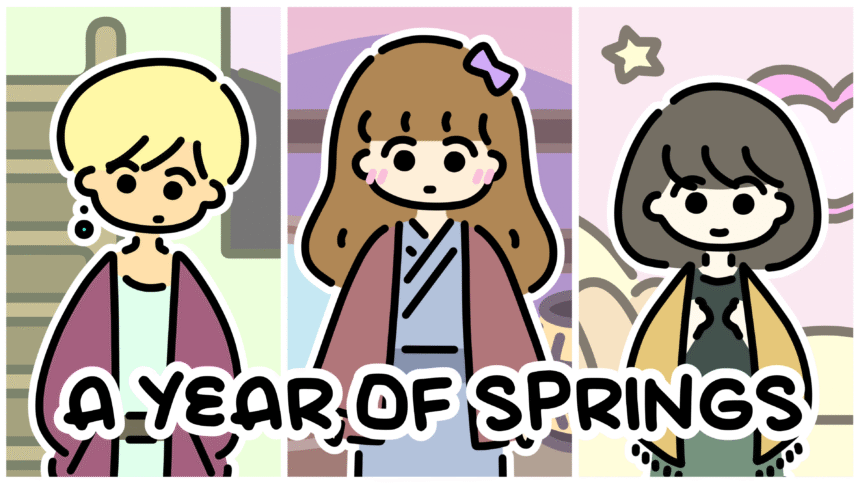If you come into A Year of Springs cold, having done no reading on the game before booting it up for the first time, you may begin to settle in for a cozy, light jaunt. However, the minimalistic and charming scene of an onsen bath overlooking a distant mountain that introduces you to this collection belies the emotional journey that you are about to experience.
A Year of Springs is a compilation of three games created over two years, 2018 to 2019, by independent developer npckc. Each game is a visual novel: for the uninitiated, this means that they take the form of largely static images, where sprites change instantaneously (or sometimes with a fading or sudden sideways shift effect, depending on the mood of the scene) while text at the bottom of the screen delivers the dialogue between our stars, as well as the inner monologue of the character you are playing as. Anyone who has played games in the Ace Attorney, Danganronpa, or Steins;Gate series will be familiar with this style.
This gameplay is accompanied by calming and melodious music that serves to both reassure during the story’s more emotionally trying moments and to reinforce the joyous times.
Overview of the Game

Each chapter is relatively bite-sized, and can be finished in under 30 minutes, even accounting for the multiple endings. The length of each chapter, though, is of no concern when the sheer amount of heart-wrenching, touching, and reaffirming moments that the player is fortunate enough to experience are so genuine and so affective.
The game is primarily concerned with the difficulties faced by sexual minorities in contemporary Japan, though its themes and the situations our leads find themselves in will likely feel familiar for LGBTQ+ people (and indeed, those who are not members of these communities) no matter where they are from. Especially now, those who have less visibility or who are – even as this review is being written – seeing their rights be eroded and rolled back, will almost certainly find something they can relate to, an experience many of the fans have said is cathartic.
Chapter by Chapter
one night, hot springs
Beginning with one night, hot springs, player character Haru is plagued with worry and concern that, because she is a trans woman who has yet to legally change her gender (a difficult process in Japan at the best of times, especially for young adults) she will be making trouble for her best friend, Manami. Manami, for her part, cannot imagine celebrating her 20th birthday – the day you become a fully-fledged adult in Japanese culture – without Haru, who she has known since childhood. Haru therefore must face the dual pressure of wanting to make her friend happy in a society that often makes her feel unwelcoming merely for being there.
Haru’s story further highlights how things that cisgender people don’t even consider to be even minor inconveniences can be fraught with difficulty and complexity for transgender people. From signing into a hotel and having to use a deadname and circle a gender that you don’t identify with for legal purposes, to being too anxious to bathe with others for fear of causing trouble for your friends, strangers around you, and yourself.
This is not to say that the game is doom and gloom, however. npkck created the game from a desire to explore and process how sexual minorities are treated without wanting to punish the player for making whatever decision they believe is right. As such, there are multiple possible endings to each chapter, but no negative conclusions, just different ones.
last night of spring

last night of spring is also somewhat centered around Haru, though this time through the eyes of Erika, Manami’s school friend. Having only recently met Haru, the first transgender person she’s ever known, Erika can be a little clumsy sometimes when navigating conversation, but never from a place of ill-will. She is also an interesting mirror to Manami: where Manami’s insistance that Haru will be accepted comes from a degree of optimistic naiveté, Erika has a more skeptical view of the world around them, but channels that frustration into trying to make things better for her new friend (and she makes it clear that she is more than willing to throw hands to protect Haru).
The official Bad Girl of the group, Erika is up front about her past as a ne’er-do-well in her all-girls school, getting into trouble and smoking. Now, though, she is trying to change her ways a little, and is deeply invested in throwing Haru a birthday party that she’d enjoy. The difficulties of the world around her mean that her plans must eventually become more pared down than initially hoped for, but it is possible to give Haru the happy birthday that she deserves. All the while, Erika is navigating her feelings for Haru, and trying to make sense of them to herself.
spring leaves no flowers

The finale to the trilogy, spring leaves no leaves, puts Manami front and center. From a technical narrative perspective, I think that this is the most accomplished of the three chapters. If you play with the intent to get each ending in order, each subsequent playthrough gets longer than the last, and the player slowly gets to understand why Manami has blindspots when it comes to relationships or intuiting the meanings behind interpersonal interactions. It concludes with a surprisingly tense moment of self-discovery, denial, and finally acceptance, and what it could mean for Manami and her partner going forward.
What Makes A Year of Springs Compelling?

For LGBTQ+ people, the fact that A Year of Springs explores the difficulties that they face in a society that doesn’t always treat them as the full people that they are, while never punishing the player for making the decisions they want, and indeed having a world that does have multiple supportive and enthusiastic allies, can be a comforting experience (as mentioned, many sexual minority players have said that they were moved by the experience).
For players who do not identify with all or even any of the protagonists’ profiles, A Year of Springs is not just an opportunity to walk a mile in someone else’s shoes and gain a greater understanding of issues that are rarely discussed in mainstream gaming (much less so thoughtfully and carefully considered – in mainstream spaces). It can also be help work through issues that you might be experiencing. Even if you are not a sexual minority, many can identify with Haru’s anxiety, or Erika’s frustration at the world, or Manami’s alarm at discovering something new about herself. This is not an explicitly educational game, but I think that it would be very difficult for any player to come away from it without learning something.
The game does not shy away from the struggles that LGBTQ+ people (and specifically LGBTQ+ women) face, but nor does it take a cynical, pessimistic view of the world, or what the world could be. npckc has said that they created some characters and situations specifically to be better, brighter, and more hopeful than the society that we live in today. It might be less realistic, but it doesn’t mean that it will be a fantasy forever. A Year of Springs does depict a new friend who is a little too blunt; businesses that won’t recognize people for who they are; and the pain that can come with needing to accept some difficult feelings. But it shines brightest when we meet a friend who is trying hard to understand you more deeply; the acceptance of your loved ones as you figure out who you are; or a stranger who wants you to enjoy the hot springs and won’t take “no” for an answer.
Verdict
This game is an easy recommendation. Whether you are a visual novel fan, are looking for something short and sweet, or want to see yourself or your friends reflected in a game in a way that they rarely are, A Year of Springs adds a blossom-like gentleness and grace to any collection.
A Year of Springs is available for Nintendo Switch, Playstation 4, Playstation 5, Xbox One, Xbox Series S and X, Windows, MacOS, Android, and Linux, and can be downloaded directly from npckc here.

